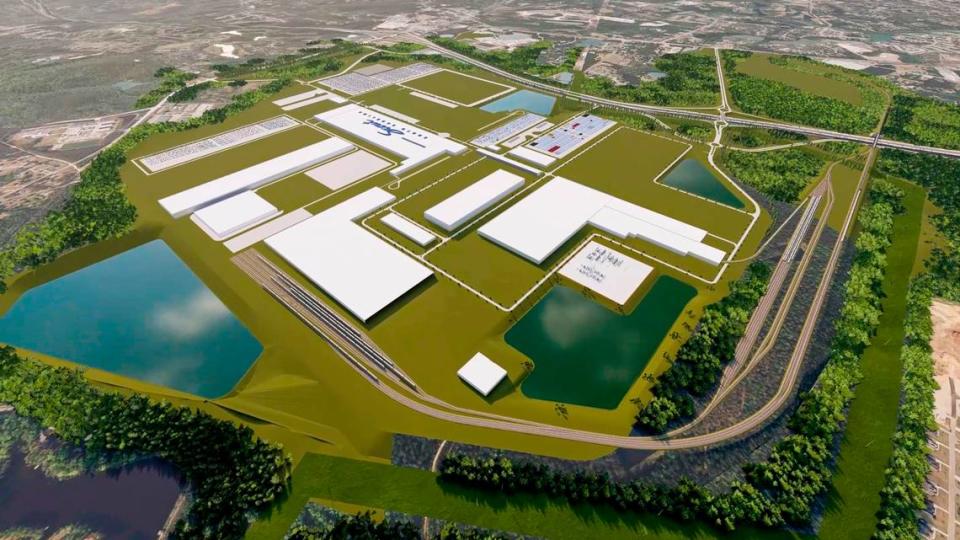Scout plant construction in Blythewood could flood Black neighborhoods, groups say
Two environmental groups are questioning the effect a new electric vehicle plant will have on the landscape in Richland County, saying the project could increase flooding in African American communities and cause more pollution.
In a letter about Scout Motors’ plan to fill wetlands, environmentalists say the federal government needs to require a detailed study of the company’s plan to destroy streams and wetlands in the Blythewood area.
The study, called an environmental impact statement, could delay the project, but conservationists say it would allow time to examine the landscape impacts, including how they might affect Black communities. Those concerns were expressed in a June 29 letter from the Southern Environmental Law Center and Congaree Riverkeeper to the U.S. Army Corps of Engineers, which must approve the request to fill wetlands
Scout is proposing to eliminate up to 74 acres of wetlands, seven miles of creeks and 38 acres of ponds for an electric vehicle plant that could create up to 4,000 jobs in the Columbia area. The company’s $2 billion investment would produce as many as 200,000 electric vehicles each year. Scout plans to break ground this year and begin production by 2026.
The Scout plant, announced in March, would be located along Interstate 77 in the rapidly growing Blythewood area north of Columbia. The project would be done in phases, the first of which would result in construction of six buildings of about 3.1 million square feet. An interchange would be built, as well as a rail spur. The next phase would include development of 25 more buildings totaling 12.9 million square feet.
Many people hailed the announcement of the Scout plant this year, including some environmentalists who support non-polluting, electric vehicles. But the Southern Environmental Law Center and Congaree Riverkeeper said “there is no denying the project will alter the area.’’
“In addition to the development itself, the growth it will induce will likely bring significantly more development, traffic, noise, and air pollution,’’ the letter said. “The new developments and increased traffic will in turn fill additional wetlands and streams and further degrade water quality in the area and downstream.’’
Communities that could experience increased flooding downstream are the historically Black neighborhoods of Lincolnshire, Haskell Heights and Denny Terrace, the law center’s comment letter to the federal government said. That’s a particular concern because the climate is changing and storms are becoming more intense, the law center’s letter said.
Patricia Gold, secretary of the Lincolnshire Community Organization, said she’s “concerned about it.’’ The Lincolnshire neighborhood, off Fairfield Road in north Columbia, had flood problems during a 2015 deluge that swamped the capital city, she said.
“I do know about the plant and that they are destroying a lot of wetlands up in the Blythewood area,’’ Gold said. “Of course, that’s going to impact those of us who are below that.’’
As it stands, the request to fill wetlands includes a plan to protect some 5,000 acres near Congaree National Park on the other side of Richland County. The wetlands offset plan also includes protecting an island in the Broad River.
Chad Johnston, an attorney representing the county and the state Department of Commerce, said detailed plans have been drawn up to prevent flooding from the Scout plant.
An onsite stormwater system is being designed to go beyond the typical requirements, he said. An analysis also is being done of downstream areas to make sure the plant doesn’t flood those areas, he said. Detention basins will help control pollution, he said in an email Wednesday.
Johnston said it’s unlikely Scout could reduce the size of the proposed manufacturing plant. He also said the commerce department and Richland County do not believe an environmental impact statement is warranted.
State Sen. John Scott, a Richland County Democrat whose district includes the Scout plant site, said downstream neighborhoods, which also are in his district, are far enough away from the site. Scott, who is African American, said the plant will mean jobs for minorities.
Lincolnshire, Haskell Heights and Denny Terrace are six to nine miles downstream from the watershed that is being developed for the project.
Critics “have been throwing rocks at this plant ever since they got started,’’ Scott said. “This is a $2 billion investment for South Carolina.’’
Bob Perry, a former state Department of Natural Resources official who now works for a company involved in the wetlands aspect of the project, said a watershed closer to the Scout site would be hard to use to offset the wetlands loss because the watershed is too urbanized and filled with utility easements.
Other concerns by the environmental groups focused on the plan to protect nearly 5,000 acres near Congaree National Park to offset the loss of wetlands.
While protecting land near Congaree would bolster protected areas near the state’s only national park, the environmental law center’s letter said the property is also near a nuclear fuel factory. That factory — Westinghouse — has groundwater contamination that could seep onto the land being preserved, the letter said. So far, the contamination has not left the property.
“Has (Scout) considered the movement of that groundwater onto the mitigation sites or considered whether it could impact the safety or quality’’ of the land to be protected? the letter asked.
An environmental impact statement could examine groundwater movement and whether anything could be done to prevent the Westinghouse pollution from oozing onto the wetlands area to be saved near the national park, environmentalists say.
Last month’s comments highlight the complexity of a major economic development project that is supposed to produce less-polluting vehicles that aren’t dependent on oil, but one that has an effect on important natural resources.
Emily Wyche, an attorney for the law center, said her organization likes the idea of building an electric vehicle plant, but it needs more detailed study.
“This will bring jobs, working on clean cars, and it’s all important and exciting,’’ she said. “But we can’t have different standards for projects we support, in terms of environmental impacts. We’re hopeful the decision makers, the applicants will continue to engage to reduce their impacts.’’


